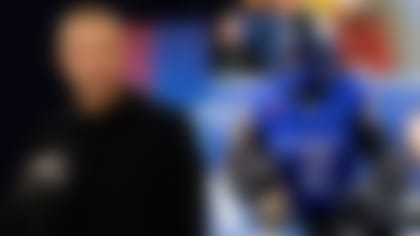In Around The NFL's "Making the Leap" series, we spotlight emerging players to keep an eye on in 2016. Whether rising from no-namer to quality starter or vaulting from standout to superstar, each of these individuals is poised to break through in the coming campaign.
Three offensive coordinators tried to cure Ryan Tannehill's deep ball over the course of four seasons. DeVante Parker did it by himself in four late-season starts. After that magic act, anything seems possible for the second-year pro.
Why Parker is on the list
Parker doesn't need to be open to make big plays. Even better: Tannehill knows it. Coasting down the stretch of another depressing Dolphins campaign, Tannehill looked determined to test-drive Parker late in 2015. The rookie responded by racking up 445 yards -- at a robust clip of 20.2 yards per reception -- in Miami's final six games. Quite encouraging, especially considering how Parker's first NFL season had transpired up to that point.
As late as Thanksgiving, Parker looked destined for a lost rookie campaign. Taken No. 14 overall in the 2015 NFL Draft, Parker struggled to shake the foot injury that limited him to six games in his senior season at Louisville. He barely practiced until a week before the regular season, and then he had a tough time moving up a crowded depth chart. Parker's year only turned around when the Dolphins had no other choice. If not for Rishard Matthews' Week 12 injury, Parker wouldn't be on this list.
The production to follow was hard to ignore. Parker had five plays over 30 yards in an offense that had failed to stretch the field all year. (Makes you wonder why the Dolphins wasted snaps on Greg Jennings for so long.) The incredible instincts and ball skills Parker had displayed in college suddenly reappeared on the NFL gridiron. His best value came from tracking deep balls, with his deceptive speed and long strides swallowing up defenders. Parker uses his 6-foot-3 frame to wall off cornerbacks and high-point the ball. His performance in Week 17 against the Patriots (five catches for 106 yards and a touchdown) helped ensure New England would not have home-field advantage in the AFC title game, possibly costing Miami's rivals another Super Bowl.
The NFL Game Pass film shows Parker is more than a simple deep threat. His ability on in-breaking routes matches up with Tannehill's strength as a passer. Despite his lanky frame, Parker does some of his best work fighting for the ball in tight quarters.
It's remarkable that Parker made such an impact when he was clearly still so raw. (More on that below.) But the final three games of the season showed Parker finding holes in zone coverage and executing timing routes. He doesn't look like the most deceptive or strongest runner, but he broke seven tackles in limited chances. In short: He's not just an athlete.
You could argue that Parker was unlucky last year, despite his strong finishing kick. We charted his 59 targets, and 12 of them were absolutely uncatchable. Parker generally did a great job pulling down contested catches, a trait that should only help more in the red zone.
Parker won't have to wait until December to make an impact this season. Matthews left town in free agency and the starting job is all Parker's now. Parker predictably got the "sky is the limit" offseason puff piece in response. We stubbornly believe Tannehill is set up to improve this year because of the pieces around him, including Parker. Part of that Tannequation -- a vastly improved offensive line and the removal of a lackluster offensive coaching staff -- should only help Parker, too.
Obstacles he'll face
The highlight-reel plays were great. But can Parker adjust when defenses jam him at the line of scrimmage?
The low point of Parker's late-season jaunt through defensive backfields came during a grim Week 14 prime-time game against the Giants. Dominique Rodgers-Cromartie and Prince Amukamara took residence in Parker's kitchen all night, and the rookie rarely had a counter move to get free. Parker recorded low scores on Matt Harmon's "Reception Perception" in part because of his struggles to get off press coverage. That's a problem if he keeps lining up as Miami's "X" receiver.
Parker's route running sometimes looked sloppy or lazy, especially when he wasn't the primary receiver on the play. More than once, he failed to help out Tannehill in scramble situations.
The bright side: Parker was learning the pro game on Sundays after a lost offseason and a regular season marred by injury and erratic practice time. His best three games were his last three. While he might never be a sudden receiver who gets separation every snap, his ball skills can make up for it.
More than anything, Parker has to stay available. The Dolphins receiver crew remains deep, with Jarvis Landry, Kenny Stills, rookie Leonte Carroo and tight end Jordan Cameron. If Parker gets hurt or is slow to pick up new coach Adam Gase's offense, Tannehill has other options.
Expectations for 2016
Every football dork has a "type" of receiver he loves to watch. I'll admit that Parker isn't my type. He's not yet a crisp route runner who can win every down and line up all over the field. There is a risk of falling in love with Parker's highlight reel while ignoring the development he needs. And yet, I can't see him failing to top 1,000 yards in his second season, like a poor man's DeAndre Hopkins. There will be quiet weeks that frustrate fantasy owners, but Parker should score enough big outings to make the leap.
In this era of "traits" and endless access to game film, a receiver's ability to catch the ball can get overlooked. Parker has an 80-inch wingspan with suction cups for hands. Even when he's not open, Parker sees the ball and catches the ball. He can figure out the rest along the way.












